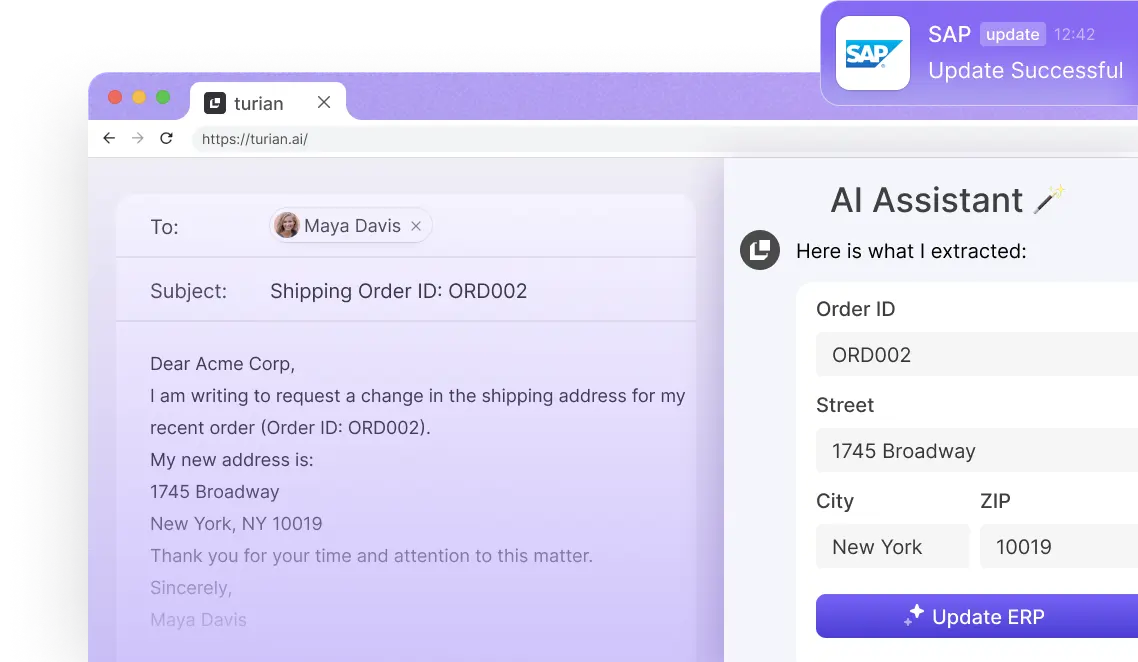

Human-in-the-Loop: Bridging the gap between AI automation and human expertise
The artificial intelligence (AI) revolution is here with over 70% of executives believing it to be the most significant business advantage of the future. As the adoption of AI integrations and tools continues to grow across all industries, businesses are exploring more and more ways to leverage AI to automate workflows and improve overall efficiency.

But there is a caveat with AI. It is still error-prone and often can’t make unsupervised decisions. It’s fun to read about hilarious recipes created by AI like Beothurtreed Tuna Pie, which included ingredients like “1 hard cooked apple mayonnaise” and “5 cup lumps; thinly sliced” 😅 and directions to “Surround with 1½ dozen heavy water by high, and drain & cut in ¼ in. remaining the skillet”. But when it comes to deploying AI for your business you don’t want to make a customer unhappy by messing up their data or sending a nonsensical email.

AI struggles to understand how context can change meaning. This classic line from the movie Animal Crackers (US, 1930) “One morning I shot an elephant in my pajamas. How he got in my pajamas, I don't know.” would make you smile, but likely leave AI puzzled. Why? Unlike rules and syntax based computer languages, human language is subtle and can vary based on the speaker, the circumstances, and the context.
One approach that helps prevent such mistakes is human-in-the-loop (HITL), which combines the strength of humans and AI to achieve the best results. Think of it as human-assisted AI.
Understanding human-in-the-loop automation
Human-in-the-loop involves the collaboration between humans and AI to perform tasks and make decisions. While AI technologies have made massive improvements in automating repetitive processes, there are still areas where human judgment and expertise are unbeatable. HITL automation bridges this gap by integrating human validation and feedback into an AI workflow.

By incorporating human input in the automation process, human-in-the-loop ensures higher accuracy and quality control. People step in to make complex or nuanced decisions that AI tools may struggle with. This interactive loop between humans and AI results in more reliable and efficient automation.
The benefits of human-in-the-loop automation
1. Enhanced accuracy and quality control
The collaboration between humans and AI with help of HITL results in a higher level of accuracy and quality control. While AI systems perform repetitive tasks (such as processing emails) at much faster speeds and with more consistency than humans, they face challenges with complex scenarios or unclear data.
Human validation helps identify and fix errors, so the automation process produces reliable results.
2. Improved adaptability and flexibility
Human-in-the-loop allows teams to adapt to changing requirements and handle exceptions effectively. With HITL, people can provide real-time feedback and make adjustments when AI comes across situations it is not familiar with yet. With such feedback AI will learn how to handle similar cases correctly.
This flexibility helps AI stay capable of learning and handling different scenarios as business requirements evolve.
3. Cost-effective scalability
Integrating human validation into AI automation workflows can be a cost-effective approach to scalability. Instead of hiring more people to manually work on processes, implementing AI takes on many of these tasks. While human-in-the-loop leverages the expertise of existing team members.
Teams can optimize this process by choosing which tasks to fully automate and which tasks require HITL.

Applications of Human-in-the-Loop automation
Ok, by now we hopefully convinced you that human-in-the-loop is a valuable framework. But how do you apply it to your workflows? AI adoption with human-in-the-loop automation is seen across all types of industries, from healthcare, to e-commerce, delivery, and banking to retail. Here are some of the examples:
1. Data extraction and validation
In industries that process a lot of incoming data, such as hospitality, finance, and insurance, human-in-the-loop plays an important role. While AI algorithms extract data, people can review and validate the data, ensuring its reliability.
For example, Uify allows for human-in-the-loop as part of the AI automation. The platform is designed for Operations teams who want to create AI-powered internal apps. It allows you to easily build custom apps, connect AI and your tool stack to automate most of the operations workflows.

One of the common use cases of Uify is data extraction from the emails. With Uify, the teams can automate data extraction from incoming emails, update internal databases, and even create personalized responses. As a quality control, the team members can review the data extracted by AI or an email drafted, and then authorize data entry to their internal systems or send the response.

2. Customer support and service
Customer support and service operations benefit a lot from human-in-the-loop enabled AI. AI-powered chatbots and virtual assistants can handle routine customer queries, but a human is often required for more complex or sensitive issues.
Support team members can step in and provide empathetic responses, understand nuanced customer needs, and resolve complex problems - all areas where AI may struggle.
3. Content moderation and compliance
In content moderation and compliance processes, human-in-the-loop helps maintain regulatory compliance and enforce community guidelines. AI systems can flag potentially problematic content, but human reviewers are making the final decisions. People can evaluate context and cultural sensitivities, and assess the appropriateness of the content, helping to keep a safe online environment.
4. Fraud detection and risk assessment
Fraud detection and risk assessment require a combination of AI algorithms and human expertise. While AI can analyze large amounts of data for patterns and anomalies, human validation is key when it comes to making decisions. People are still much better than AI at interpreting complex patterns, identifying false positives or negatives. They provide important input to improve the accuracy of fraud detection systems.
How to implement human-in-the-loop automation
Alright, by now you’re ready to add AI with human-in-the-loop to your daily work. And you now probably have a use case in mind. Are you thinking about tackling that always flooded inbox? 😉
If you want to implement human-in-the-loop enabled AI for your team, check out the steps below:
1. Identify the process
Identify processes within your business that would benefit from AI automation. Look for high volume tasks that still require human judgment, decision-making, or handling of exceptions. Evaluate the potential impact of automation on these processes, considering things like accuracy, scalability, and cost-effectiveness. Very often such processes lay within email automation, which is one of the most time consuming tools in each company.
2. Define roles and responsibilities
Clearly define the responsibilities of your team and AI in the automation process. Define which tasks will be automated and which ones require human input. Uify lets you set up human authorization required before important actions (e.g. when you re-write data in your internal systems, or before sending out an email).
3. Train employees
You’ll want your team to be part of the AI automation process, so provide them with the training to understand the basics of AI as well as their role in workflow automation.
4. Establish feedback
Create feedback loops to enable continuous improvement. Encourage team members to give feedback on the performance of the AI systems and suggest areas for optimization. Regularly review and analyze the feedback to identify patterns, address challenges, and tune the automation process.
5. Monitor your AI performance
Monitor and evaluate the performance of the AI workflow. Track key performance indicators, such as accuracy, efficiency, and customer satisfaction, to assess the effectiveness of your automation. Analyze data to identify opportunities for further optimization.

Human-in-the-loop is a great way to add AI automation to workflows. By combining the strengths of humans and AI models, you can increase productivity while keeping accuracy high.
Embrace the power of human-in-the-loop automation and unleash the full potential of AI in your company.

Say hi to your
AI Assistant!


Lernen Sie Ihren KI-Assistenten kennen!
.avif)






